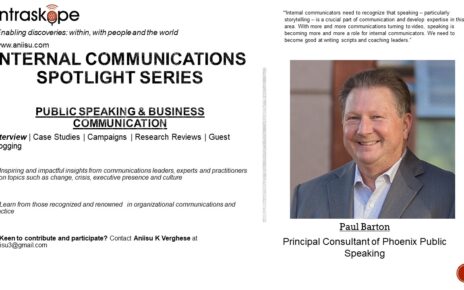Is a senior leader expected to be in your office shortly? Keen to add value with internal communications and make the most of your leader’s time?
Planning leadership visits can be a scramble unless you set clear objectives, craft effective plans and define success measures. Such visits can take up a whole lot of time and successful internal communicators are those who are flexible, agile and have a nose for opportunities.
Look up the following tips to conduct a successful leader visit at your organization.
Clarify the purpose: Leaders use visits to share their strategies, meet employees, gauge the pulse among staff, witness changes as they unfold and be present for important events. Ask: what does the leader positively want to achieve? Also, what does the leader not want to miss? Remember, that the leader may have a mix of agendas – 1:1 meetings, press briefings, launches or focus group discussions to moderate among others. Outline the potential questions you can ask audiences after the leader’s visit.
Shape the agenda: As an internal communicator you can also spot and recommend opportunities that the leader can participate in and optimize time and effort. For example, there may be specific audiences who need ‘face time’ or the local charity giving program can get a boost if a leader shows up for the event. You can consider other opportunities such as meeting high performing teams or recognizing innovative groups. The leader can also speak on the brand, core values or culture if you believe those are crucial themes to address. Block time to capture ‘sound bytes’ of the leader. Think of events that you plan to host in the future where this leader’s messages can be aired in case he or she can’t make it in person.
Simplify the process: Leaders visiting from other geographies can mean that you have to consider jetlag, time difference constraints and many employees and peers seeking their time. Make life easier by planning sessions and events that limits commute time and requires a lot of preparation. Have a plan that allows leaders to take ‘time off’ and get ‘mindspace’ so that the leader can recharge. Buffer lead time for the leader to come in and settle down before getting into the thick of things. Factor in time in between sessions to debrief and catch-up on e-mails.
Define your messages: Think of what you want the leader to achieve from each session. Articulate the messages each audience needs to hear. Think of the actions you expect your audiences to take after the leader visit. Clarify the behavior changes expected of your employees.
Maximize coverage: If there are multiple offices to cover and it seems unviable for the leader to visit them all consider videoconferencing, live video streaming or even playing a recording of the messages for your far flung locations.
Promote the leader: Not everyone may know the leader. Look up the leader’s bio and identify opportunities to market the visit. You may want to build buzz around a specific event and it will need a well-structured communication plan. If the leader is comfortable using his or her photograph in the communication it can serve to help employees put a ‘face’ to the name. At one such leader visit we conducted a quiz which generated a lot of attention and interest. We also pointed employees to the company’s intranet page for information about the leader.
Detail the visit: While the agenda is helpful the specifics of each event will ensure there are no surprises. A simple approach is to call out the event, objective(s), participants, venue, logistics, duration, format and outcomes expected. Align all local leaders on the visit agenda, plan and expectations.
Promoting the visit: Host an article or a summary video of the visit so that those who weren’t able to attend the events or meet the leader can learn more about the visit. If there is a significant media opportunity you can think of sharing information about the visit on your company’s social media assets. Have the leader ‘leave’ behind an autographed coffee table book or sign a register to mark the visit. That can later be used to continue promotions inside the office. Collate post event surveys and share a summary with the leader and stakeholders.
Have fun: If your leader is open to it and if your culture allows try blending fun with business. You can even attempt a prank on your leader if there is appetite for practical jokes! Your employees would love to see the ‘other’ side of your leader. A word of caution: be sure your practical joke considers cultural sensitivities and doesn’t infringe on your organization’s values.
Are there other suggestions to make your leader visit tick? Share them here.

Aniisu, this is great information packaged nicely on one page! Your writing is fantastic, and I’m glad I discovered it on LinkedIn via the Internal Communications group.
Tammy
Thanks Tammy! Appreciate you dropping by and sharing your thoughts.
Aniisu Very usefull information Thanks for sharing.